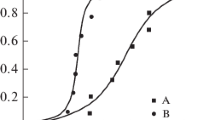Conclusions
-
1.
A method has been proposed for determining the stress concentration factor in a cylindrical specimen with unilateral crack loaded in cantilever bending, based on the method of measuring the elastic ompliance of a specimen. Results obrained by this method for 15G2AFDps steel and boiler steel are in good agreement with test data for specimens in eccentric tension.
-
2.
It was es tablished that the value of the dimensionless, coefficient Y2 at one and the same relative crack length\(\bar l\) has little dependence on the relative area\(\bar F\) in a wide range of variation of the latter and the crack shape.
Similar content being viewed by others
Literature Cited
1974 Annual Book of ASTM Standards, Part 10, E399-74.
W. F. Brown Jr. and J. E. Srawley, Plane Strain Crack Toughness Testing of High Strength Metallic Materials, ASTM, Philadelphia (1967).
V. S. Ivanova and V. G. Kudryashov, “Methods of determining fracture toughness KIc from fatigue test data,” Probl. Prochn., No. 3 (1970).
Y. S. Segal, A Study of the Kinetics of Fatigue Macrofailure, Author's Abstract of Candidate's Thesis, RKIIGA, Riga (1970).
S. E. Gurevich and L. A. Édidovich “Crack propagation, velocity and critical values of the stress intensity factor during fatigue fracture,” in: Fatigue and Fracture Toughness of Metals, V. S. Ivanova (editor), Nauka, Moscow (1974).
G. R. Irwin, “Relation of stress es near a crack to the crack extension force,” Proc. 9th, Intern. Congr. Appl. Mech., Brussels, 1957.
V. T. Troshchenko and V. V. Pokrovskii, “Method for investigating the characteristics of fatigue fracture of metals under harmonic and combined loads at low temperatures,” Probl. Prochn., No. 2 (1973).
A. F. Voitenko and N. V. Novikov, “Facility for studying the elasticity and internal friction characteristics of materials in the temperature range 3–3000°K,” Zavod. Lab., No. 5 (1973).
B. A. Drozdovskii (editor), Applied Problems in Fracture Toughness [Russian translation], Mir, Moscow (1968).
Additional information
Institute of Strength Problems, Academy of Sciences of the Ukrainian SSR, Kiev. Translated from Problemy Prochnosti, No. 1, pp. 3–8, January, 1977.
Rights and permissions
About this article
Cite this article
Troshchenko, V.T., Pokrovskii, V.V. & Prokopenko, A.V. Determining fracture toughness from the results of fatigue tests in circular bending. Strength Mater 9, 1–7 (1977). https://doi.org/10.1007/BF01534604
Received:
Issue Date:
DOI: https://doi.org/10.1007/BF01534604




